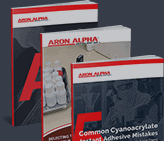Trends in the Use of Cyanoacrylates and Mechanical Fastening in Industrial Assembly
This post has been designed to provide insight as to the trends and economic shifts when it comes to the general category of adhesives and mechanical fastening technology for industrial applications.
While the overall rate of increase of adhesive consumption since 1950 has been high, the growth of certain types of products has been especially dramatic. For example, pressure sensitive and hot melt formulations have been very rapid gainers and anaerobic adhesives have been strong performers in recent years. Specialty adhesives, including cyanoacrylates, the so called instant glues and ultraviolet radiation cured products have also been favorably received. The variety of different applications for which they are used is particularly impressive. Even a casual review of industry literature reveals that welded mechanically fastened designs are regularly being replaced by adhesive assemblies. The reverse situation is extremely rare.
Many industries are embracing adhesives and sealants. These industries include medical, packaging, automotive, electronics, footwear, construction repair and remodeling, textiles, consumer goods, and shipbuilding. Among all of the applications, packaging, construction industry, durable assembly and transportation sectors account for a major part of adhesives and sealants consumption.
Adhesives, like mechanical fasteners, are easy to apply or install manually. Also, like mechanical screws and rivets, applying adhesives can be automated. This is a growing trend as engineers across industry lines are always looking to lower production and labor costs, reduce product weight and increase quality and consistency.
A large number of adhesives have been developed to meet and exceed engineers’ process and performance needs. These needs include reducing assembly and processing speed, product durability and aesthetics. The adhesives can also be customized to provide a mix of benefits. Adhesives can, for example, be formulated with a range of different viscosities and even made into tapes and films.
Other advances continue to be made in developing adhesives based on specific industry trends and demands. For example, low-odor adhesives fill a need for safer and more comfortable work environments. Adhesives that do not use volatile organic solvents have been formulated to meet environmental and sustainability initiatives. With design factors in mind, using adhesives can replace rivets and weld lines, and enable lightweight and cost efficient designs.
Bonding Dissimilar Materials and Composites
Materials with different coefficients of thermal expansion (CTEs) contract and expand differently under temperature variations. Mechanical fasteners do not allow expansion or contraction of joined materials during temperature variations without causing damage or unsightly bulging. Some adhesives have the flexibility to accommodate movements caused by thermal expansion of the substrates even after they have fully cured. In addition, adhesives do not require putting holes in metal parts that may have protective coatings or paint. This allows the metal underneath the layer of adhesive to stay protected from the elements. In this way, adhesives prevent damage induced by thermal expansion and maintain protective coatings on materials, lengthening the life of the joint and product. This is a major reason the trend is shifting from mechanical to adhesive.
Adhesives also work to lower costs by increasing productivity and efficiency during assembly. With adhesives, there is no grinding off weld marks, adding sealant to make the design waterproof, or straightening warped pieces. Throughput becomes faster.
Issues When Switching
When selecting an adhesive to replace one or more types of mechanical fasteners, it’s important to address the following issues:
Process: How can adhesives or tapes be used in manufacturing processes? This could be manual or automated assembly depending upon part sizes, volume, and other factors.
End-use: How and where will the final product be used? For example, there may be environmental requirements for the assembly like extreme temperature, UV, or chemical resistance.
Assembly: What type of assembly is required? It could be a simple as attaching trim or a gasket, mounting panels to framework, or full surface lamination.
Substrate: What materials to be assembled? For example, joining dissimilar materials may require a more flexible adhesive to accommodate differences in movement or thermal expansion.
Cost: Can money-saving improvements be made in the assembly process? Using adhesives and tapes often reduces labor, process steps, or lets less expensive materials be used.
Summary:
The trend from mechanical fastening to adhesives in industrial assembly is growing. But because adhesives can differ so much in strength and purpose, it is imperative for an engineer to partner with the right supplier who can assist in these assembly challenges and provide insight on the best solutions. For more information, contact Toagosei America at 1-800-338-5192 for your project consultation and technical assistance.
{{cta(‘e67411e5-e440-4a6b-88de-5760fe311292’)}}




